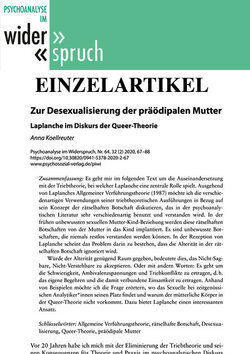22 Seiten, PDF-E-Book
Erschienen: November 2020
Bestell-Nr.: 22476
https://doi.org/10.30820/0941-5378-2020-2-67
abonnieren
Anna Koellreuter
Zur Desexualisierung der präödipalen Mutter (PDF)
Laplanche im Diskurs der Queer-Theorie
Sofortdownload
Dies ist ein E-Book. Unsere E-Books sind mit einem personalisierten Wasserzeichen versehen,
jedoch frei von weiteren technischen Schutzmaßnahmen (»DRM«).
Erfahren Sie hier mehr zu den Datei-Formaten.
Es geht mir im folgenden Text um die Auseinandersetzung mit der Triebtheorie, bei welcher Laplanche eine zentrale Rolle spielt. Ausgehend von Laplanches Allgemeiner Verführungstheorie (1987) möchte ich die verschiedenartigen Verwendungen seiner triebtheoretischen Ausführungen in Bezug auf sein Konzept der rätselhaften Botschaft diskutieren, das in der psychoanalytischen Literatur sehr verschiedenartig benutzt und verstanden wird. In der frühen unbewussten sexuellen Mutter-Kind-Beziehung werden diese rätselhaften Botschaften von der Mutter in das Kind implantiert. Es sind unbewusste Botschaften, die niemals restlos verstanden werden können. In der Rezeption von Laplanche scheint das Problem darin zu bestehen, dass die Alterität in der rätselhaften Botschaft ignoriert wird.
Abstract:
In the following text, I am concerned with dealing with the drive theory, in which Laplanche plays a central role. Starting from Laplanche’s Theory of general seduction (1987), I would like to discuss the various uses of his drive-theoretical explanations in relation to his concept of the enigmatic message, which is used and understood very diversely in psychoanalytic literature. In the early unconscious sexual mother-child relationship, these puzzling messages are implanted by the mother into the child. They are unconscious messages that can never be fully understood. In the reception of Laplanche’s theory, the problem seems to be that the alterity is ignored in the enigmatic message. If there was enough space for alterity, it would mean accepting what cannot be said or understood. Or in other words: it is about the difficulty of enduring tensions of ambivalence and instinctual conflicts, i.e. to endure your own desire and the loneliness associated with it. Using examples, I would like to discuss the question of where sexuality finds its place with contemporary analysts and why the mother’s body does not appear in queer theory. Laplanche offers an interesting approach to this question.
Abstract:
In the following text, I am concerned with dealing with the drive theory, in which Laplanche plays a central role. Starting from Laplanche’s Theory of general seduction (1987), I would like to discuss the various uses of his drive-theoretical explanations in relation to his concept of the enigmatic message, which is used and understood very diversely in psychoanalytic literature. In the early unconscious sexual mother-child relationship, these puzzling messages are implanted by the mother into the child. They are unconscious messages that can never be fully understood. In the reception of Laplanche’s theory, the problem seems to be that the alterity is ignored in the enigmatic message. If there was enough space for alterity, it would mean accepting what cannot be said or understood. Or in other words: it is about the difficulty of enduring tensions of ambivalence and instinctual conflicts, i.e. to endure your own desire and the loneliness associated with it. Using examples, I would like to discuss the question of where sexuality finds its place with contemporary analysts and why the mother’s body does not appear in queer theory. Laplanche offers an interesting approach to this question.
Lily GramatikovS. 5–7Editorial (PDF)
Sabine MetzgerS. 9–48Weit mehr als eine »Perle«: Die Klitoris (PDF)
Anlässlich einer Wiederentdeckung aus der Biologie zur Psychoanalyse der weiblichen SexualitätBarbara RendtorffS. 49–65Was »ist« das Weibliche - so es denn existiert? (PDF)
Anna KoellreuterS. 67–88Zur Desexualisierung der präödipalen Mutter (PDF)
Laplanche im Diskurs der Queer-TheorieEdith SeifertS. 89–100Sexualität oder Gender (PDF)
Psychoanalyse versus P.B. PreciadoEdeltraud Tilch-BauschkeS. 101–113Die göttliche (männliche?) Ordnung (PDF)
Über den Kampf fürs Frauenwahlrecht und die Angst vor VeränderungRolf VogtS. 115–122Laudatio zum 75. Geburtstag von Herrn Prof. Dr. med. Hans Becker (PDF)
Anja Guck-NigrelliS. 123–126Rezension von: Annette Streeck-Fischer (Hrsg.). (2018). Die frühe Entwicklung. Psychodynamische Entwicklungspsychologien von Freud bis heute (PDF)
Sabine MetzgerS. 9–48Weit mehr als eine »Perle«: Die Klitoris (PDF)
Anlässlich einer Wiederentdeckung aus der Biologie zur Psychoanalyse der weiblichen SexualitätBarbara RendtorffS. 49–65Was »ist« das Weibliche - so es denn existiert? (PDF)
Anna KoellreuterS. 67–88Zur Desexualisierung der präödipalen Mutter (PDF)
Laplanche im Diskurs der Queer-TheorieEdith SeifertS. 89–100Sexualität oder Gender (PDF)
Psychoanalyse versus P.B. PreciadoEdeltraud Tilch-BauschkeS. 101–113Die göttliche (männliche?) Ordnung (PDF)
Über den Kampf fürs Frauenwahlrecht und die Angst vor VeränderungRolf VogtS. 115–122Laudatio zum 75. Geburtstag von Herrn Prof. Dr. med. Hans Becker (PDF)
Anja Guck-NigrelliS. 123–126Rezension von: Annette Streeck-Fischer (Hrsg.). (2018). Die frühe Entwicklung. Psychodynamische Entwicklungspsychologien von Freud bis heute (PDF)

